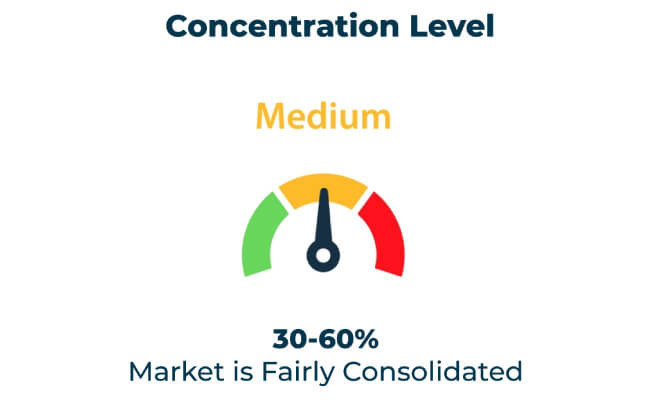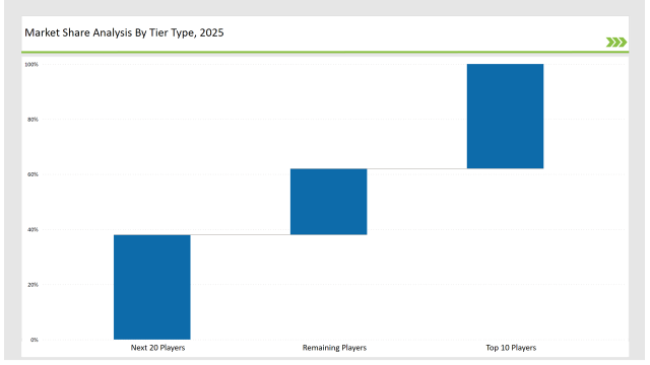The packer bottle packaging sector is evolving fast as firms address their durability, sustainability, and the consumers' convenience. With increasing demands across pharmaceuticals, nutraceuticals, personal care, and food industries, manufacturers are enhancing bottle designs with more tamper-proof seals, lightweight materials, or ecofriendly alternatives. They have also combined smart packaging features, high-barrier coatings, and recyclable polymers to improve safety and functionality.
It is developing the automatic molding processes, AI-driven defect detection, and precision sealing technologies involved in packer bottle production to optimize efficiency and integrity in products. The industry trends include packages made of PCR plastics, biodegradable bottles, and reusable glass substitutes, matching international trends for sustainability.
Tier 1 players such as Berry Global, Gerresheimer, and Alpha Packaging constitute 37% of the market as a result of their presence in innovation in material, precision molding, and global supply chain capabilities.
The tier 2 companis includes Amcor, Comar, and Alpla Group, which dominate 39% of the market by providing economical, customized, and specialty packer bottles specifically designed for pharmaceuticals, supplements, and personal care products.
Tier 3 players includes regional and niche players focused on refillable, high-barrier, and lightweight packer bottles which represent about 24% of the market. These businesses invest in localized production and sustainable innovations, all the while targeting premium bottle designs.
| Category | Market Share (%) |
|---|---|
| Top 3 (Berry Global, Gerresheimer, Alpha Packaging) | 19% |
| Rest of Top 5 (Amcor, Comar) | 10% |
| Next 5 of Top 10 (Alpla Group, Silgan Plastics, Pretium Packaging, Weener Plastics, United Caps) | 8% |

Packer bottles have uses in various industries where product safety, strength, and environment-friendliness are important. Business groups are turning innovative to develop more trusted packages, minimize wastage, and adhere to evolving regulatory requirements. They are developing multi-layer barrier technology to enhance product preservation. Producers are incorporating smart tamper-evident markers to enhance customer confidence and safeguarding.
Producers are developing packer bottles with new sealing technologies, light-weight designs, and smart tracking functionality. They are using high-impact resistant materials to improve strength without increasing weight. Firms are also fortifying UV-resistant coatings to keep sensitive contents safe from degradation. Firms are also incorporating ergonomic designs to maximize consumer convenience and handling.
Sustainability and product protection are driving the packer bottle market revolution. Companies are integrating AI-based defect detection, light-weight resin chemistry, and advanced sealing technology to enhance packaging integrity. Companies are investing in reusable and recyclable packs to minimize environmental impact. Manufacturers are launching child-resistant caps and smart caps for tamper-evident packs. In addition, companies are adding NFC-enabled technology to upgrade product traceability and customer engagement.
Technology suppliers should focus on automation, advanced material innovations, and smart packaging features to support the evolving packer bottle market. Partnering with pharmaceutical, nutraceutical, and personal care brands will drive innovation and market growth.
| Tier Type | Example of Key Players |
|---|---|
| Tier 1 | Berry Global, Gerresheimer, Alpha Packaging |
| Tier 2 | Amcor, Comar, Alpla Group |
| Tier 3 | Silgan Plastics, Pretium Packaging, Weener Plastics, United Caps |

Front-running producers are pushing packer bottle tech through AI-based quality control, eco-friendly material breakthroughs, and intelligent packaging solutions. Corporations are creating ultra-lightweight bottles to minimize plastic usage while ensuring strength. Marketers are also incorporating antimicrobial coatings to improve cleanliness and increase product shelf life. Companies are implementing energy-efficient production methods to minimize carbon footprints.
| Manufacturer | Latest Developments |
|---|---|
| Berry Global | Launched fully recyclable packer bottles in March 2024. |
| Gerresheimer | Developed tamper-evident pharmaceutical bottles in April 2024. |
| Alpha Packaging | Expanded child-resistant PCR bottle production in May 2024. |
| Amcor | Released refillable packer bottles for personal care in June 2024. |
| Comar | Strengthened airtight supplement bottle designs in July 2024. |
| Alpla Group | Introduced energy-efficient molding technology in August 2024. |
| Silgan Plastics | Pioneered smart caps with RFID tracking in September 2024. |
The packer bottle market is evolving as companies invest in sustainable materials, AI-driven defect detection, and smart packaging innovations. They are incorporating lightweight yet durable materials to enhance bottle resilience while minimizing plastic use. Additionally, manufacturers are optimizing production efficiency through high-speed molding technologies. Businesses are also integrating tamper-evident closures to improve security and regulatory compliance.
Manufacturers will continue refining AI-driven defect detection, lightweight bottle designs, and high-barrier packaging solutions. Companies will expand refillable and biodegradable bottle production to meet sustainability goals. Smart packer bottles with authentication and tracking features will gain traction in pharmaceuticals and nutraceuticals. Additionally, predictive analytics and automated quality control will improve production efficiency, reduce waste, and enhance customization. Businesses will integrate nanotechnology-based barrier coatings to extend product shelf life. Firms will also adopt AI-powered material optimization to improve recyclability and minimize raw material use.
Leading players include Berry Global, Gerresheimer, Alpha Packaging, Amcor, Comar, Alpla Group, and Silgan Plastics.
The top 3 players collectively control 19% of the global market.
The market shows medium concentration, with top players holding 37%.
Key drivers include sustainability, AI-driven quality control, smart packaging, and tamper-proof solutions.
Explore Packaging Formats Insights
View Reports
Thank you!
You will receive an email from our Business Development Manager. Please be sure to check your SPAM/JUNK folder too.